| September 01, 2008 |  |
MarsDaily Advertising Kit |
| Previous Issues | Aug 29 | Aug 28 | Aug 27 | Aug 26 | Aug 25 |
Phoenix Mission Conducting Extended Activities On Mars Tucson AZ (SPX) Sep 01, 2008
Tucson AZ (SPX) Sep 01, 2008NASA's Phoenix Mars Lander, having completed its 90-day primary mission, is continuing its science collection activities. Science and engineering teams are looking forward to at least another month of Martian exploration. Due to the spacecraft's sufficient power and experiment capacity, NASA announced on July 31 that the mission would continue operations through Sept. 30. Once the lander ... more NASA Mars Rover Opportunity Ascends To Level Ground  Pasadena CA (SPX) Sep 01, 2008
Pasadena CA (SPX) Sep 01, 2008NASA's Mars Exploration Rover Opportunity has climbed out of the large crater that it had been examining from the inside since last September. "The rover is back on flat ground," an engineer who drives it, Paolo Bellutta of NASA's Jet Propulsion Laboratory, announced to the mission's international team of scientists and engineers. Opportunity used its own entry tracks from nearly a ... more Antarctic Research Helps Shed Light On Climate Change On Mars  Boston MA (SPX) Sep 01, 2008
Boston MA (SPX) Sep 01, 2008Researchers examining images of gullies on the flanks of craters on Mars say they formed as recently as a few hundred thousand years ago and in sites once occupied by glaciers. The features are eerily reminiscent of gullies formed in Antarctica's mars-like McMurdo Dry Valleys. The parallels between the Martian gullies and those in Antarctica's McMurdo Dry Valleys were made using the latest ... more Phoenix Lander Pictures Show Robotic Arm's Workspace After 90 Sols  Tempe AZ (SPX) Aug 29, 2008
Tempe AZ (SPX) Aug 29, 2008New pictures from NASA's Phoenix Lander show just what a busy summer the spacecraft on Mars - and its science team at The University of Arizona in Tucson - has been having. During the first 90 Martian days, or sols, after its May 25, 2008, landing on an arctic plain of Mars, the lander dug several trenches in the workspace reachable for its robotic arm. The lander's Surface Stereo ... more Fresh From Mars: Scientist To Describe H20 Discovery  Dallas TX (SPX) Aug 28, 2008
Dallas TX (SPX) Aug 28, 2008Water on Mars? Scientists suspected the presence of H2O on the surface of our planetary next-door neighbor, but it took a series of tests and University of Texas at Dallas Professor John Hoffman's instrument aboard NASA's Phoenix Mars Lander to prove it. Hoffman will tell audiences at the Museum of Nature and Science on Aug. 30 how he and his team made one of this century's first major ... more |
mars-mers
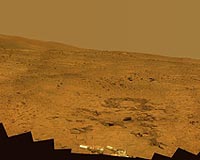 mars-phoenix 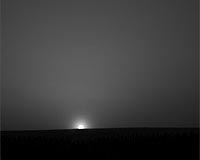 asteroid 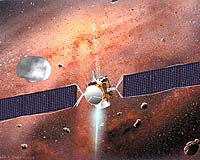 |
 Moffett Field CA (SPX) Aug 27, 2008
Moffett Field CA (SPX) Aug 27, 2008NASA's Phoenix Mars Lander has taken the first-ever image of a single particle of Mars' ubiquitous dust, using its atomic force microscope. The particle -- shown at higher magnification than anything ever seen from another world -- is a rounded particle about one micrometer, or one millionth of a meter, across. It is a speck of the dust that cloaks Mars. Such dust particles color the ... more Phoenix Digs Deeper As Third Month Nears End  Tucson AZ (SPX) Aug 26, 2008
Tucson AZ (SPX) Aug 26, 2008The next sample of Martian soil being grabbed for analysis is coming from a trench about three times deeper than any other trench NASA's Phoenix Mars Lander has dug. On Tuesday, Aug. 26, the spacecraft will finish the 90 Martian days (or "sols") originally planned as its primary mission and will continue into a mission extension through September, as announced by NASA in July. Phoenix lander ... more Liquid Water in the Martian North  Moffett Field CA (SPX) Aug 25, 2008
Moffett Field CA (SPX) Aug 25, 2008Perchlorate. Never heard of it? Join the club. But NASA's Phoenix spacecraft has found it in the soil in the icy northern plains of Mars. And now that it's been found, scientists are scrambling to explain how it got there, and what, if anything, its presence means about the habitability of the martian north. Phoenix didn't go to Mars to find perchlorate. It went looking for evidence of ... more Meteorite Fast Track  Moffett Field CA (SPX) Aug 25, 2008
Moffett Field CA (SPX) Aug 25, 2008For the last few years, astronomers have faced a puzzle: The vast majority of asteroids that come near the Earth are of a type that matches only a tiny fraction of the meteorites that most frequently hit our planet. Since meteorites are mostly pieces of asteroids, this discrepancy was hard to explain, but a team from MIT and other institutions has now found what it believes is the answer to the ... more |
mars-phoenix
 microsat  mars-life 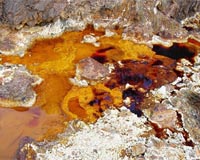 |
 Tucson AZ (SPX) Aug 22, 2008
Tucson AZ (SPX) Aug 22, 2008NASA's Phoenix Mars Lander scientists and engineers are continuing to dig into the area around the lander with the spacecraft's robotic arm, looking for new materials to analyze and examining the soil and ice subsurface structure. New trenches opened recently include the "Burn Alive 3" trench in the "Wonderland" digging area in the eastern portion of the arm's reachable workspace. Research ... more NASA to use shock-absorbers to fix shaking in new Ares rocket  Washington (AFP) Aug 20, 2008
Washington (AFP) Aug 20, 2008NASA say they will use shock-absorbers similar to those used in cars to fix a problem with heavy vibrations in the new Ares rocket, to give stronauts inside the Orion crew capsule a smoother ride. US space agency engineers have recommended a system employing spring-mounted weights and shock-absorbing tubes between the first and second stage of the rocket to rectify excessive vibrations. ... more Spirit Waiting Out The Winter  Pasadena CA (SPX) Aug 18, 2008
Pasadena CA (SPX) Aug 18, 2008Spirit's battery levels are slowly edging upward, thanks to a slight decrease in atmospheric dust (Tau) and a gradual increase in sunlight as winter gives way to spring. Early in the week, Spirit spent two Martian days carrying out contingency plans following a temporary delay in data transmission from Earth. Spirit implemented the so-called "runout" portion of an earlier master sequence ... more Phoenix Camera Sees Morning Frost At The Landing Site  Temps AZ (SPX) Aug 18, 2008
Temps AZ (SPX) Aug 18, 2008The Surface Stereo Imager, or SSI, on NASA's Phoenix Mars Lander has seen water frost on the ground around the spacecraft's landing site. Water frost appears in an image the SSI took on Aug. 14, 2008, at 6 a.m. local Mars time on Sol 79, the 79th Martian day after landing. The frost begins to disappear shortly after 6 a.m. as the sun rises on the landing site. The sun was about 22 ... more
|
mars-general
 mars-phoenix 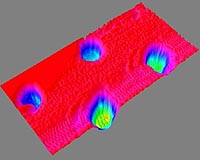 spacetravel 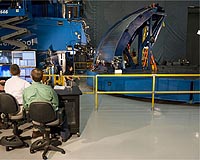 |
| Previous Issues | Aug 29 | Aug 28 | Aug 27 | Aug 26 | Aug 25 |
| The contents herein, unless otherwise known to be public domain, are Copyright 1995-2007 - SpaceDaily. AFP and UPI Wire Stories are copyright Agence France-Presse and United Press International. ESA Portal Reports are copyright European Space Agency. All NASA sourced material is public domain. Additional copyrights may apply in whole or part to other bona fide parties. Advertising does not imply endorsement, agreement or approval of any opinions, statements or information provided by SpaceDaily on any web page published or hosted by SpaceDaily. Privacy statement |